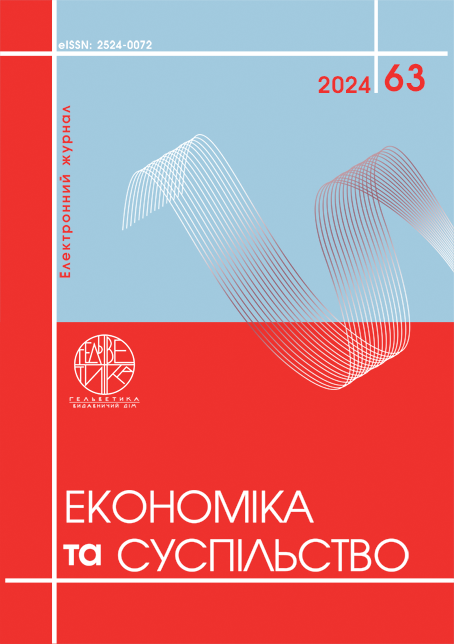ANALYSIS OF PRICING MODELS AND REGIONAL FEATURES ON THE IT OUTSOURCING MARKET
Abstract
The study of pricing models in the outsourcing market is essential and relevant because it helps companies make informed decisions, increase efficiency, reduce costs and risks, and improve the quality of services provided and received. This research deepens knowledge about pricing models and regional features in the IT outsourcing market. The global IT outsourcing market is expected to grow at a CAGR of 7.7% through 2027. According to Deloitte, 59% of companies said cost reduction is a crucial reason for outsourcing IT professionals. Scientific publications on IT outsourcing pricing indexed in the Scopus database were analyzed. The types of IT outsourcing were analyzed, and their differences and advantages were studied, particularly onshoring, nearshoring and offshoring. Onshoring outsourcing specialists are located in the same country as the client organization. Nearshoring specialists are abroad but in neighbouring countries at the same time zone. Offshoring staff are in more distant countries with a time difference between countries of at least 5-6 hours. IT outsourcing pricing models were analyzed, including time and materials, unit/on-demand pricing, fixed pricing, cost-plus, performance-based pricing, gain-sharing, and shared risk-reward. Most contracts awarded by IT outsourcing companies were found to be awarded on a time-and-materials or fixed-price basis. Time rates and benefits of outsourcing locations by region are analyzed. It was established that the average rate of a software developer in Eastern Europe varies between 30-65 US dollars, in Asia – from 20 to 45 US dollars, in Latin America – 35-70 US dollars, in Africa – 25-45 US dollars. It was determined that the main regional features are the availability of talented specialists, the competitiveness of prices and the geographical location of the region, which influence companies' decisions regarding the choice of a place for outsourcing IT projects. It was determined that Eastern Europe is the best outsourcing region for IT companies that want high-quality service without compromising product quality.
References
GrandViewResearch (2030). IT Services Outsourcing Market Size & Share Report. Available at: https://www.grandviewresearch.com/industry-analysis/it-services-outsourcing-market
Deloitte US. (2022). Global Outsourcing Survey 2022. Available at: https://www2.deloitte.com/us/en/pages/operations/articles/global-outsourcing-survey.html
Y.B. Chang, V. Gurbaxani, K. Ravindran, "Information technology outsourcing: Asset transfer and the role of contract," MIS Quarterly: Management Information Systems, vol. 41, no. 3, pp. 959–973, 2017. DOI: https://doi.org/10.25300/MISQ/2017/41.3.13
J.C. Dos Santos, M.M. Da Silva, "Price management in IT outsourcing contracts. The path to flexibility," Journal of Revenue and Pricing Management, vol. 14, no. 5, pp. 342–364, 2015. DOI: https://doi.org/10.1057/rpm.2014.41
D.M. Jain, R. Khurana, "Impact of pricing and outsourcing models on Indian information technology service outsourcing," Benchmarking, vol. 22, no. 4, pp. 610–623, 2015. DOI: https://doi.org/10.1108/BIJ-01-2014-0011
D.M. Jain, R. Khurana, "An empirical comparison of pricing models in information technology service outsourcing in Indian context," Benchmarking, vol. 22, no. 4, pp. 697–710, 2015. DOI: https://doi.org/10.1108/BIJ-03-2014-0019
J.C. Dos Santos, M.M. Da Silva, "Mapping critical success factors for IT outsourcing: The providers' perspective," International Journal of Enterprise Information Systems, vol. 11, no. 1, pp. 62–84, 2015. DOI: https://doi.org/10.4018/ijeis.2015010105
Y. Chen, A. Bharadwaj, "An empirical analysis of contract structures in IT outsourcing," Information Systems Research, vol. 20, no. 4, pp. 484–506, 2009. DOI: https://doi.org/10.1287/isre.1070.0166
S. Cullen, P.B. Seddon, L.P. Willcocks, "IT outsourcing configuration: Research into defining and designing outsourcing arrangements," Journal of Strategic Information Systems, vol. 14, no. 4, pp. 357–387, 2005. DOI: https://doi.org/10.1016/j.jsis.2005.07.001
H.K. Bhargava, S. Sundaresan, "Computing as utility: Managing availability, commitment, and pricing through contingent bid auctions," Journal of Management Information Systems, vol. 21, no. 2, pp. 201–227, 2004. DOI: https://doi.org/10.1080/07421222.2004.11045806
M. Turner, A. Smith, H. Smith, "It outsourcing: The challenge of changing technology in it outsourcing agreements," Computer Law and Security Report, vol. 18, no. 3, pp. 181–186, 2002. DOI: https://doi.org/10.1016/S0267-3649(02)00508-3
M.K.O. Lee, "IT outsourcing contracts: Practical issues for management," Industrial Management and Data Systems, vol. 96, no. 1, pp. 15–20, 1996. DOI: https://doi.org/10.1108/02635579610107684
DesignRush. "Outsourcing QA: Benefits, Reasons to Do it & Best Practices." Available at: https://www.designrush.com/agency/software-development/trends/outsourcing-qa
ManpowerGroup. (2023). IT outsourcing in 2022: Full Guide. Available at: https://brocoders.com/blog/what-is-it-outsourcing/
SinQ. (n.d.). Offshore vs Onshore. Available at: https://www.sinq.co/post/offshore-vs-onshore/
Entrance Consulting. (n.d.). Onshore vs Nearshore vs Offshore. Available at: https://entranceconsulting.com/onshore-vs-nearshore-vs-offshore/
KIMON Services. (n.d.). What is Nearshore Outsourcing? Available at: https://kimonservices.com/what-is-nearshore-outsourcing/
TTEC. (n.d.). Nearshore Outsourcing. Available at: https://www.ttec.com/glossary/nearshore-outsourcing
Copyright (c) 2024 Андрій Конопленко, Богдан Ковальов, Артем Боруха

This work is licensed under a Creative Commons Attribution 4.0 International License.


